Professor Y.C. Wong - Four decades as my mentor, colleague and friend
SIU Man Keung, Department of Mathematics, University of Hong Kong
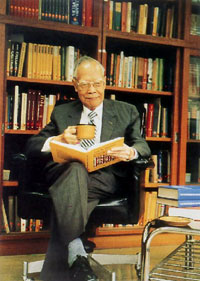 This is the first time I use powerpoint for presentation
[powerpoint file, with larger photos and more details about the photos].
When I gave talks the organizer usually asked, "Do you need to use powerpoint?"
My usual answer was , "No, I have neither the power nor the point."
This is the first time I use powerpoint for presentation
[powerpoint file, with larger photos and more details about the photos].
When I gave talks the organizer usually asked, "Do you need to use powerpoint?"
My usual answer was , "No, I have neither the power nor the point."
Today, on this very happy occasion, I have both the power and the point :
the power because of the technical support from my colleagues, TSING Nam Kiu, CHAN Siu Yan, Mimi LUI and a former graduate, LEE Man Sang of the Faculty of Education, the point because of the many things to say about an esteemed teacher, colleague and friend, Professor Y.C. Wong.
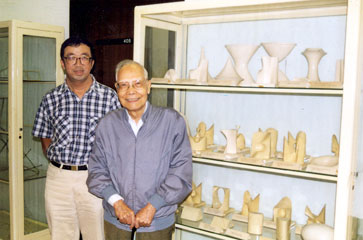
When I was a young boy in school, I heard about the name WONG Yung-Chow from my late uncle who got acquainted with Professor Wong during their MIT days.
As a young boy I did not pay as much attention to mathematics as to ping-pong,
so what was in my mind was that they played ping-pong and Professor Wong usually got the upper hand. Several years later I entered HKU in the autumn of 1963
[HKU Calendar 1963]
-- you can see why I say "four decades" in my title.
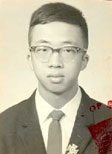 I was sitting in the classroom face to face with this legendary figure who excels in both ping-pong and mathematics (and maybe in many more areas of which I am not aware)
I was sitting in the classroom face to face with this legendary figure who excels in both ping-pong and mathematics (and maybe in many more areas of which I am not aware)
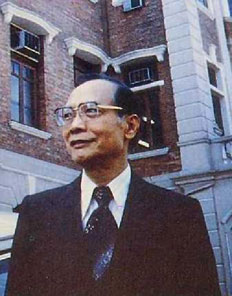 It was the tradition then to have the first series of lectures for freshmen delivered by Professor Wong himself. Although everybody knew that those lectures were meant to be an appetizer rather than the staple food and that the material covered would never come up in any examination, the mathematics was sufficiently elegant and interesting to captivate many young minds. I still keep the set of lecture notes (look here!) On the first page Professor Wong outlines his famous "five steps to study" :
It was the tradition then to have the first series of lectures for freshmen delivered by Professor Wong himself. Although everybody knew that those lectures were meant to be an appetizer rather than the staple food and that the material covered would never come up in any examination, the mathematics was sufficiently elegant and interesting to captivate many young minds. I still keep the set of lecture notes (look here!) On the first page Professor Wong outlines his famous "five steps to study" :
- Preparing before the lecture.
- Attending the lecture.
- Reviewing after the lecture.
- Doing exercises.
- Looking back.
Nowadays this will be labelled as "to learn how to learn" - good things never change, the slogan notwithstanding!
Then there follows a template for hand-in homework. [Pages of lecture notes] Everybody should follow this way of writing a homework, with a wide margin for comments by the teacher. Nowadays such rules will probably be dismissed by most students with scorn. But we were brought up that way and the good working habit still serves us in good stead.
Now I will share with you two results in these lectures.
- The first result, expounded by Charles-Ange Laisant in 1877, is about four squares erected on the sides of a quadrilateral. The two straight lines joining the centres of the squares on opposite sides are of equal length and perpendicular to each other. The quadrilateral can be convex or concave or even self-intersecting, or it can even be degenerated into a triangle, a line (or a point)!
[Demonstration using the Geometer's Sketchpad]
- The second result is of a similar nature but more fascinating. It has been known since the late 19th century the following interesting property about the triangle formed by the vertices of three isosceles triangles of the same shape erected on the sides of a given arbitrary triangle. If the isosceles triangle has vertex angle 120 degrees, then the newly formed triangle is always equilateral and the straight lines joining the new vertices to the opposite vertices of the original triangle are concurrent. [Demonstration using the Geometer's Sketchpad] If the three added triangles are of the same shape but not of that particular shape, then some of these nice properties may not hold true anymore. [Demonstration using the Geometer's Sketchpad] For about 70 years nobody could answer when these are true and when these are not. In 1941 Professor Wong, signing himself as a "(Boxer) Indemnity Funds Student", published a paper titled "Some properties of the triangle" in volume 48 of the American Mathematical Monthly that settles the question completely. [1941 paper] Isosceles triangle of vertex angle 120 degrees is the only case which makes the newly formed triangle equilateral no matter what the original triangle looks like. The proof is a novel application of computation by complex numbers.
In 1968 Professor Wong extended the discussion to polygons and published a paper titled "Some extensions of the Douglas-Neumann theorem for concentric polygons" in volume 75 of the American Mathematical Monthly. Three weeks ago when I browsed over a recent issue of the same journal I found a paper referring to the work of Professor Wong : Stephen B. Gray, "Generalizing the Petr-Douglas-Neumann theorem on N-gons", American Mathematical Monthly, 110 (2003), 210-227.
References
- Y.C. Wong, Some properties of the triangle, American Mathematical Monthly, 48 (1941), 530-535.
- Y.C. Wong, Some extensions of the Douglas-Neumann theorem for concentric polygons, American Mathematical Monthly, 75 (1968), 470-482.
- S.B. Gray, Generalizing the Petr-Douglas-Neumann theorem on N-gons, American Mathematical Monthly, 110 (2003), 210-227.
In my undergraduate years I learnt a lot from all my teachers in the Department of Mathematics, a place with a kind of warmth towards which I was already drawn. Several of my teachers, who now reside in different parts of the world, ask me to convey their greetings to Professor Wong. Were it not for the problem of SARS, some of them would have come back on this occasion.
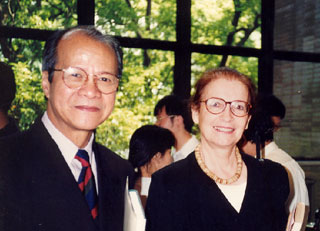 LEUNG Kam Tim in France and Doris CHEN in England say, "Happy birthday, Professor Wong!"
LEUNG Kam Tim in France and Doris CHEN in England say, "Happy birthday, Professor Wong!"
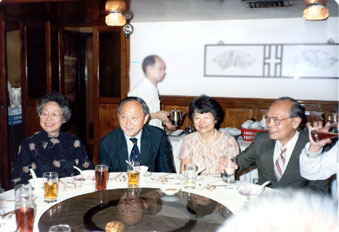 They each sends their personal greetings through two baskets of beautiful flowers from afar.
They each sends their personal greetings through two baskets of beautiful flowers from afar.
CHANG Chao Ping
in New Zealand says, "I joined the department as a tutor in 1957.
During the time I received immense help, both academic and personal, from Professor Wong, which enabled me to pursue postgraduate study in the United States two years later.
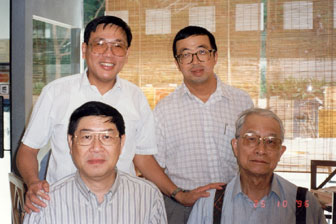 On this occasion of Professor Wong's 90th birthday I would like to sincerely pay tribute to Professor Wong and wish him a very happy birthday and very happy life in many future years to come."
On this occasion of Professor Wong's 90th birthday I would like to sincerely pay tribute to Professor Wong and wish him a very happy birthday and very happy life in many future years to come."
LIU Ming Chit in the United States says, "What a special occasion and opportunity for me to express my deep appreciation to Professor Y.C. Wong. It was an afternoon in June 38 years ago when Professor Wong, then head of the Department of Mathematics, interviewed and later admitted me to be a B.Sc. (Special) student in HKU. Since then, my life has changed. I have had the most enjoyable, fulfilling 35 years of academic life in the University of Hong Kong. Professor Wong is always there to support me, to provide me with academic freedom and independence. He has greatly, positively influenced my life. I am thankful for this opportunity to express my gratitude. Professor Wong, happy 90th birthday!"
 In the autumn of 1967 I went to Columbia University for graduate study.
That year three from HKU got fellowships from Columbia -- POON Chung Kwong, SIT Yu and I.
That is quite a record for applicants from one single university, considering that
the Department of Mathematics at Columbia in those days admitted only 10 to 15 first year graduate students
from all over the world each year. Very likely Professor Wong had given us a strong helping hand in this.
(There are two more graduates of this department in the photo.
In the autumn of 1967 I went to Columbia University for graduate study.
That year three from HKU got fellowships from Columbia -- POON Chung Kwong, SIT Yu and I.
That is quite a record for applicants from one single university, considering that
the Department of Mathematics at Columbia in those days admitted only 10 to 15 first year graduate students
from all over the world each year. Very likely Professor Wong had given us a strong helping hand in this.
(There are two more graduates of this department in the photo.
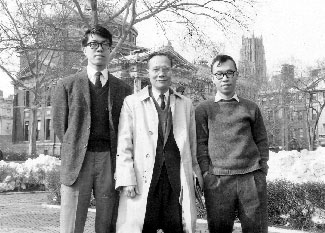 The beautiful bride is LAW Kwan Yuk, and the tall chap at the back is LAI Tze Leung.)
Before us LAM Tsit Yuen and WONG Chak Kuen studied at Columbia.
The beautiful bride is LAW Kwan Yuk, and the tall chap at the back is LAI Tze Leung.)
Before us LAM Tsit Yuen and WONG Chak Kuen studied at Columbia.
The following year LAI Tze Leung came to join us but in Department of Mathematical Statistics. After us LUK Hing Sun and SIT Cho Wei came to study at Columbia. SIT Yu and LAW Kwan Yuk ( now both at the City University of New York) send their greetings from New York.
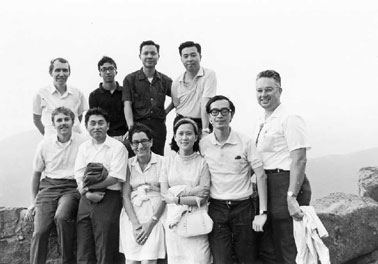 SIT Yu recounts the story of transferring from the B.Sc. programme to the B.A. programme in order to concentrate on mathematics -- in those days a B.Sc. programme meant a double major in two out of the five subjects in botany, chemistry, mathematics, physics and zoology. He says, " I suppose Professor Wong must have something to do with my transfer from the B.Sc. programme to the
B.A. programme. I do not recall the exact moment or cause that prompted me to make this switch. However, I do know that I was much influenced by all the excellent teaching staff under the leadership of Professor Wong at the Department of Mathematics at the time. My switch was the first and an unprecedented request and it could not have been approved without the support from Professor Wong."
SIT Yu recounts the story of transferring from the B.Sc. programme to the B.A. programme in order to concentrate on mathematics -- in those days a B.Sc. programme meant a double major in two out of the five subjects in botany, chemistry, mathematics, physics and zoology. He says, " I suppose Professor Wong must have something to do with my transfer from the B.Sc. programme to the
B.A. programme. I do not recall the exact moment or cause that prompted me to make this switch. However, I do know that I was much influenced by all the excellent teaching staff under the leadership of Professor Wong at the Department of Mathematics at the time. My switch was the first and an unprecedented request and it could not have been approved without the support from Professor Wong."
 LAW Kwan Yuk recalls, still with relish, a memorable banquet held at Professor Wong's residence on University Drive in the year she worked as a demonstrator in the department.
LAW Kwan Yuk recalls, still with relish, a memorable banquet held at Professor Wong's residence on University Drive in the year she worked as a demonstrator in the department.
LAI Tze Leung (now at Stanford University) says, "I must thank Professor Wong for preparing me for my academic career during my three undergraduate years at HKU and the fourth year in the department as a demonstrator. The pro-seminar course which he introduced to the programme and which he attended every time was really great training and eye-opening for a novice like me in those days. It also gave me an early head-start in giving lectures and "thinking on my feet" when asked by him (who always had incisive comments and good advice) and other members of the audience. When I look back on my career, I feel extremely fortunate in having several great teachers and mentors, and Professor Wong is one of them. In fact I never thought of going into academia when I received my B.A. from HKU, but Professor Wong changed my mind as he offered me a demonstrator position in the department and encouraged me to pursue advanced studies. Through him I saw happiness and excitement in a career in teaching and research."
Indeed Professor Wong shows his continual interest and concern in all his students. Here is a letter he wrote to me on October 17, 1969. [Letter of 17.10.69] I like to draw your attention to the last paragraph :
"Thank you very much indeed for your most interesting and informative letter of October 11, 1969. ...... I appreciate very much your taking the trouble to write us such a long letter. It must have taken you two or three hours of your valuable time. Perhaps you should arrange among yourselves to take turn to do this."
Good and kind advice. Professor Wong does not know that I write long letters as a kind of therapy, whenever I have no progress with my mathematical pursuit. My colleagues will know that now I still write a lot of long letters (in the form of emails).
Despite writing long letters I managed to obtain my Ph.D. and got my first teaching post at University of Miami. Here is another letter Professor Wong wrote to me on November 29, 1972. [Letter of 29.11.72] I draw your attention to this paragraph :
"You said you are a beginning teacher, but what you said in that letter as well as an earlier one about what a teacher should do is very similar to what I learn from my long experience as a teacher. If you keep on using your imagination and experimenting in this way, you may some day become an outstanding teacher of mathematics."
What encouragement and what modesty! For lack of imagination, that "some day" is still some days away for me, but I am thankful for his letter.
In 1975 I returned to my alma mater, to the department which initiated me into the wonderful realm of mathematics. On a hot August day I reported to duty, and to my great delight to meet Professor Wong who was at the time the Acting Head of Department. He told me that I would teach queueing theory in September. I told him I did not know anything about queueing theory.
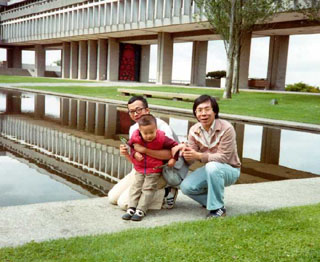 He gave me not only useful advice but also warm encouragement, and he convinced me that one can always learn some new things. That meeting proves to be a valuable lesson for me. After coming out of his office the first member of the department I met was a young demonstrator who reported to duty a bit earlier than I, YIU Yu Hung. Right away we engaged in mathematical discussion and became good friends.
His passion for euclidean geometry matches that of Professor Wong's. YIU Yu Hung is now with Florida Atlantic University and edits a journal-on-web called FORUM GEOMETRICORUM. It is his idea that I should make use of the Geometer's Sketchpad to illustrate Professor Wong's theorem. He asks me to send greetings to Professor Wong on this happy occasion.
He gave me not only useful advice but also warm encouragement, and he convinced me that one can always learn some new things. That meeting proves to be a valuable lesson for me. After coming out of his office the first member of the department I met was a young demonstrator who reported to duty a bit earlier than I, YIU Yu Hung. Right away we engaged in mathematical discussion and became good friends.
His passion for euclidean geometry matches that of Professor Wong's. YIU Yu Hung is now with Florida Atlantic University and edits a journal-on-web called FORUM GEOMETRICORUM. It is his idea that I should make use of the Geometer's Sketchpad to illustrate Professor Wong's theorem. He asks me to send greetings to Professor Wong on this happy occasion.
There is another thing I should thank Professor Wong for. In 1978 the Hong Kong Mathematical Society nominated two local mathematicians for the IMU Young Mathematician Award (under the age of 35) to enable them to attend the International Congress of Mathematicians at Helsinki. I am quite sure Professor Wong had put in a good word for me, so that I, together with MOK Kam Ping of the then Hong Kong Polytechnic, received the award.
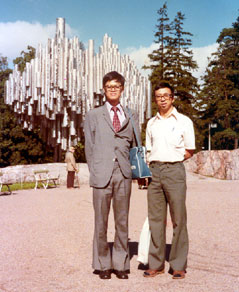 This opportunity of attending an international conference was the first one I enjoyed since coming back -- I say so because the research environment of Hong Kong in the 1970s and 1980s was quite different from what it is now, with virtually no funding nor conference grant in most disciplines. This opportunity proves to be quite crucial in helping me to remain in touch with the wider academic community outside, and urging me to keep up in research and scholarship. MOK Kam Ping wrote his Ph.D. thesis under the supervision of Professor Wong, then taught for a long time at the then Hong Kong Polytechnic before he emigrated to Australia. From Australia he sends back this greetings to Professor Wong, "Health and longevity and perpetual happiness to Professor Wong on this occasion of his 90th birthday (in Chinese)."
This opportunity of attending an international conference was the first one I enjoyed since coming back -- I say so because the research environment of Hong Kong in the 1970s and 1980s was quite different from what it is now, with virtually no funding nor conference grant in most disciplines. This opportunity proves to be quite crucial in helping me to remain in touch with the wider academic community outside, and urging me to keep up in research and scholarship. MOK Kam Ping wrote his Ph.D. thesis under the supervision of Professor Wong, then taught for a long time at the then Hong Kong Polytechnic before he emigrated to Australia. From Australia he sends back this greetings to Professor Wong, "Health and longevity and perpetual happiness to Professor Wong on this occasion of his 90th birthday (in Chinese)."
|
欣逢黃教授九十華誕 謹祝教授健康長壽, 永遠幸福。 |
| 莫錦屏 2003.5.20 |
Now I have a few confessions to make - three things I did behind Professor Wong's back!
- I made sketches of Professor Wong in class. I must add that I was extremely attentive in class apart from those odd moments. These cartoons display an undergraduate's youthful admiration for the grandeur of ancient Greek geometry in general and the virtuosity of a great teacher in particular. [Cartoon 1] [Cartoon 2]
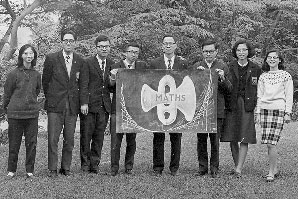 The HKUSU Science Society held its Silver Jubilee Exhibition in December of 1965. I helped with the mathematics section. There is one model in the collection of the department which I very much wanted to borrow for display. I was in a hurry to get it because it was the Saturday before the opening of the Exhibition on the following Monday. I summed up my courage, and that of my classmate LAM Kin, to go together to the department.
The HKUSU Science Society held its Silver Jubilee Exhibition in December of 1965. I helped with the mathematics section. There is one model in the collection of the department which I very much wanted to borrow for display. I was in a hurry to get it because it was the Saturday before the opening of the Exhibition on the following Monday. I summed up my courage, and that of my classmate LAM Kin, to go together to the department.
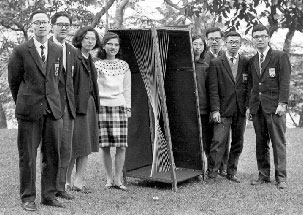 Professor Wong was not in, so we spoke to his secretary. I mumbled something about borrowing the model and mumbled in an even more devious manner something equivalent to a "yes" when she asked whether Professor Wong had given his approval. Alas, I did not know Professor Wong lived so near to the Main Building where the department was then located. The dutiful secretary called up Professor Wong at home. He would come back right away. You can imagine the hard time we had, standing before Professor Wong to face the music -- young man, this is not the proper way to do things, ... you should first discuss the matter with me, ... and all that.
Professor Wong was not in, so we spoke to his secretary. I mumbled something about borrowing the model and mumbled in an even more devious manner something equivalent to a "yes" when she asked whether Professor Wong had given his approval. Alas, I did not know Professor Wong lived so near to the Main Building where the department was then located. The dutiful secretary called up Professor Wong at home. He would come back right away. You can imagine the hard time we had, standing before Professor Wong to face the music -- young man, this is not the proper way to do things, ... you should first discuss the matter with me, ... and all that.
 But when I pointed out the very interesting feature of the model which made me want to get it in earnest for the Exhibition, apparently that touched a right mathematical chord with Professor Wong. His stern countenance quickly softened to a beaming smile, and he went into details of the making of the model and its underlying geometry. We left his office with the model snuggly in my hands.
But when I pointed out the very interesting feature of the model which made me want to get it in earnest for the Exhibition, apparently that touched a right mathematical chord with Professor Wong. His stern countenance quickly softened to a beaming smile, and he went into details of the making of the model and its underlying geometry. We left his office with the model snuggly in my hands.
- A couple of years ago I arranged with a publisher in Mainland China to have Professor Wong featured in a collection of biographies of Chinese mathematicians. I even have his personal memoir on the early part of his career translated into Chinese. Professor Wong read the text only after the book was published. With the kind permission of the Jiangsu Education Press this biography and memoir are reprinted in the programme you are now holding in your hands.
My classmate LAI Tze-Leung asks me to send his greetings to Professor Wong. What he says sums up what many of us wish to say the same. Let me end my presentation with it :
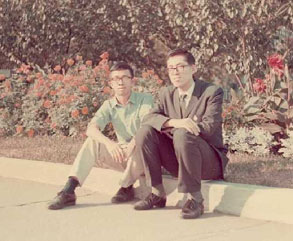
... Therefore thank you again, Professor Wong, and best wishes. Your six decades as mathematician and educator have touched on many lives, and mine is one of them.
Lai Tze-Leung
May 21, 2003
| Happy Birthday and Many Happy Returns, Professor Wong! Best Wishes to You, Professor Wong and Mrs. Wong! |
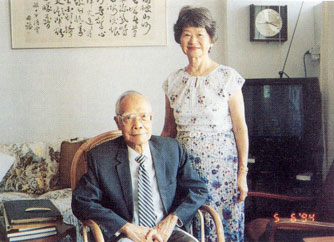 |
May 31, 2003. | |
